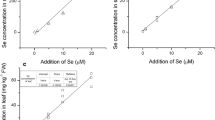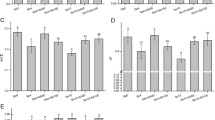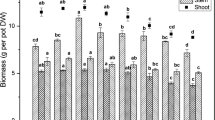Abstract
The aim of this study was to evaluate the selenium (Se) tolerance and exploit the physiological mechanisms in roots, stem, and leaves of three alfalfa cultivars to different concentrations of Se for 60 days. Among three cultivars, Medicago sativa ssp. displayed the highest Se concentrations in tissues, the largest Se amount in aerial parts, the highest bioconcentration factor (BCF) in aerial parts, and translocation factor (TF) under Se stress. Under Se stress, induced O2 •− production in roots and leaves and increases in free proline and activities of antioxidative enzymes were observed in M. sativa ssp. Based on the above results, it is concluded that M. sativa ssp. is superior to the other two cultivars for Se phytoremediation, and its well-coordinated physiological changes under Se stress confer the great Se tolerance of this cultivar.


Similar content being viewed by others
Reference
Bañuelos GS, Fakra SC, Walse SS, Marcus MA, Yang SI, Pickering IJ, Pilon-Smits EA, Freeman JL (2010) Selenium accumulation, distribution, and speciation in spineless prickly pear cactus: a drought- and salt-tolerant, selenium-enriched nutraceutical fruit crop for biofortified foods. Plant Physiol 155:315–327
Barbara HN, Sławomir D, Małgorzata W (2014) Selenium affects physiological parameters and phytochelatins accumulation in cucumber (Cucumis sativus L.) plants grown under cadmium exposure. Sci Hortic 172:10–18
Cabannes E, Buchner P, Broadley MR, Hawkesford MJ (2011) A comparison of sulfate and selenium accumulation in relation to the expression of sulfate transporter genes in Astragalus cultivars. Plant Physiol 157:2227–2239
Dai HP, Shan CJ, Lu C, Jia GL, Wei AZ, Sa WQ, Yang TX (2012) Response of antioxidant enzymes in Populus × canescens under cadmium stress. Pakistan J Bot 44(6):1943–1949
Dai HP, Shan CJ, Jia GL, Yang TX, Wei AZ, Zhao H, Wu SQ, Huo KK, Chen WQ, Cao XY (2013) Responses to cadmium tolerance, accumulation and translocation in Populus × canescens. Water Air Soil Poll 224:1504
Dai HP, Shan CJ, Zhao H, Li JC, Jia GL, Jiang H, Wu SQ, Wang Q (2015) The difference in antioxidant capacity of four alfalfa cultivars in response to Zn. Ecotoxicol Environ Safe 114:312–317
Ding Y, Wang R, Guo J, Wu F, Xu Y, Feng R (2015) The effect of selenium on the subcellular distribution of antimony to regulate the toxicity of antimony in paddy rice. Environ Sci Pollut Res 22:5111–5123
Feng R, Wei C, Tu S, Liu Z (2013) Interactive effects of selenium and antimony on the uptake of selenium, antimony and essential elements in paddy-rice. Plant Soil 365:375–386
Feng RW, Liao GJ, Guo JK, Wang RG, Xu YM, Ding YZ, Mo LY, Fan ZL, Li NY (2016) Responses of root growth and antioxidative systems of paddy rice exposed to antimony and selenium. Environ Exp Bot 122:29–38
Fariduddin Q, Yusuf M, Ahmad I, Ahmad A (2014) Brassionsteroids and their role in response of plants to abiotic stresses. Biol Plant 58:9–17
Filek M, Zembala M, Hartikainen H, Miszalski Z, Kornaś A, Wietecka-Posłuszny R, Walas P (2009) Changes in wheat plastid membrane properties induced by cadmium and selenium in presence/absence of 2, 4-dichlorophenoxyacetic acid. Plant Cell Tissue Organ Cult 96:19–28
Liu XW, Zhao ZQ, Hu CX, Zhao XH, Guo ZH (2016) Effect of sulphate on selenium uptake and translocation in rape (Brassica napus L.) supplied with selenate or selenite. Plant Soil 399:295–304
Lu Y, Li XR, He MZ, Zhao X, Liu YB, Cui Y, Pan YX, Tan HJ (2010) Seedlings growth and antioxidative enzymes activities in leaves under heavy metal stress differ between two desert plants: a perennial (Peganum harmala) and an annual (Halogeton glomeratus) grass. Acta Physiol Plant 32:583–590
Malik JA, Goel S, Kaur N, Sharma S, Singh I, Nayyar H (2012) Selenium antagonises the toxic effects of arsenic on mungbean (Phaseolus aureus Roxb.) plants by restricting its uptake and enhancing the antioxidative and detoxification mechanisms. Environ Exp Bot 77:242–248
Mostofa MG, Fujita M (2013) Salicylic acid alleviates copper toxicity in rice (Oryza sativa L.)seedlings by up-regulating antioxidative and glyoxalase systems. Ecotoxicology 22:959–973
Nadgórska-Socha A, Ptasiński B, Andrzej K (2013) Heavy metal bioaccumulation and antioxidative responses in Cardaminopsis arenosa and Plantago lanceolata leaves from metalliferous and non-metalliferous sites: a field study. Ecotoxicology 22(9):1422–1434
Nóra L, Lyudmila L, Peter S, Zsuzsanna K, Gábor A, Kristóf L, Zsuzsanna K (2016) Nitro-oxidative stress contributes to selenite toxicity in pea (Pisum sativum L). Plant Soil 400:107–122
Špela M, Vekoslava S, Mateja G (2013) The uptake and distribution of selenium in three aquatic plants grown in Se (IV) solution. Aquat Toxicol 128-129:53–59
Yu Y, Zhang S, Wen B, Huang H, Luo L (2011) Accumulation and speciation of selenium in plants as affected by arbuscular mycorrhizal fungus Glomus mosseae. Biol Trace Elem Res 143:1789–1798
Wei SH, Ji D, Twardowska I, Li YM, Zhu JG (2015) Effect of different nitrogenous nutrients on the cadmium hyperaccumulation efficiency of Rorippa globosa (Turcz.) Thell. Environ Sci Pollut Res 22:1999–2007
Acknowledgements
This work was financially supported by the National Natural Science Foundation of China (41571300) and the Natural Science Foundation of Shannxi Province (2015JM3086) and supported by Foundation of Gansu Key Laboratory of Biomonitoring and Bioremediation for Environmental Pollution (GBBL2015006, QBXTZ(P)-15-7).
Author information
Authors and Affiliations
Corresponding author
Additional information
Responsible editor: Philippe Garrigues
Rights and permissions
About this article
Cite this article
Dai, H., Jia, G. Effects of Se on the growth, tolerance, and antioxidative systems of three alfalfa cultivars. Environ Sci Pollut Res 24, 15196–15201 (2017). https://doi.org/10.1007/s11356-017-9137-8
Received:
Accepted:
Published:
Issue Date:
DOI: https://doi.org/10.1007/s11356-017-9137-8




